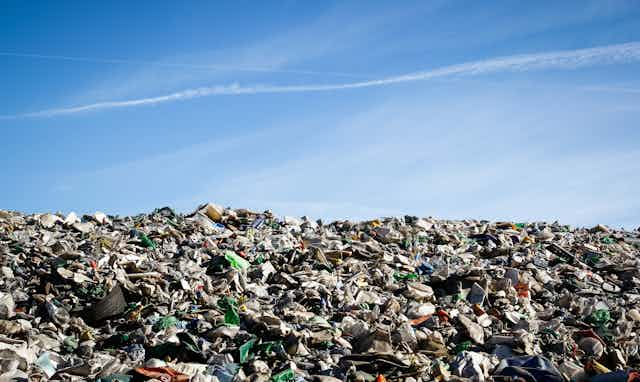Cryptocurrencies like Bitcoin may fill news headlines, but attention has been shifting to the technology that underpins them: blockchains. Blockchains are virtual ledgers on which data can be permanently stored. They are a public record, so they are very transparent and accountable.
The Big Four accounting firms, IBM and JP Morgan have been driving uptake by investigating applications. Blockchains could transform everything from national government systems to payment apps for coffee chains to the fight against climate change.
They are also starting to make a difference to the world’s waste problem. As we shall see, this has exciting possibilities.
What a waste
Despite significant progress, the weight equivalent of one SUV is still going to landfill every year for each of the circa 500m people in the EU. Waste litters our oceans, beaches and wider environment, making it one of the pressing issues of our times – not least thanks to David Attenborough’s popular Blue Planet series for the BBC, whose last episode addressed waste directly.
It is becoming harder to just shift it elsewhere – witness China’s recent ban on importing plastic waste, for example. Most countries are far behind Sweden, which has such a well developed network of waste-to-energy plants that it imports waste to feed them.

So where do blockchains fit in? They are a sophisticated way of recording transactions without having one central institution like a bank controlling them. They comprise a series of blocks, each containing a set of transactions such as sales of assets or other transfers of value.
It’s almost impossible to tamper with the information these blocks contain, since each has a unique tag of numbers and letters known as a cryptographic hash, overlaid with other complicated security mechanisms. Blockchains are so reliable that the ability of governments and central banks to control currency in future is very much in question.
Various waste initiatives have seen potential to incorporate this technology. One is the Plastic Bank, a global recycling venture founded in Canada to reduce plastic waste in developing countries – so far Haiti, Peru, Colombia and the Philippines, with plans to extend this year.
The initiative rewards people who bring plastic rubbish to bank recycling centres, and one option is blockchain-secured digital tokens. These can purchase things like food or phone-charging units in any store using the Plastic Bank app.
The plastic is meanwhile bought by companies and recycled into new consumer products. The system attracts them because blockchain’s transparency means they can see where their investment goes.
A more novel use of blockchains is meanwhile emerging in French rail. Waste management in stations has traditionally been chaotic, with up to six providers sorting endless rubbish. The central station in Lyon, for example, produces 360 tonnes of waste each year.
A new system developed by SNCF subsidiary Arep uses blockchain to allow detailed information to be collected. There is a block for each station bin, which uses Bluetooth to continually update on quantities of each type of waste, which waste managers collected it and how it is being moved around.

Station managers can use this data to see what providers have done and when. This enables them to improve waste management and optimise sorting. In a pilot, this saved almost €2,000 (£1,746) in one month in one station by facilitating a new system for collecting five different streams of waste separately.
Blockchains are also being mooted to underpin a system for trading waste quotas similarly to how carbon quotas are traded under the EU Emissions Trading System. Using blockchains could help keep track of how much waste companies are producing, and could also help facilitate trading.
Next steps
These are various ways in which this technology can help address our waste problem, but they all focus on existing waste. They don’t look at the full life cycle of products from when they are created to when they are thrown away.
For a proper life cycle approach to waste, we need to think about holding the companies responsible who made the products in the first place – as well as other companies in the supply chain, since they will potentially put pressure on the producers.
We need to introduce standards to underpin this shift in responsibility, along with costly penalties for those who infringe them. Some incentives exist already – the EU’s extended producer responsibility, for example – but countries don’t tend to implement them because of issues around tracking the waste and enforcing the rules. Again, blockchain technologies could have a role here.

When goods are produced, responsibility for them could be assigned. This would be recorded as a transaction to be stored in a block on the blockchain, identifying the product and the responsible party. Every time the product was transferred – when it was sold, say, or when it was disposed of in landfill – this would be recorded in a new transaction. This could all be accessible via a QR code stamped on each product.
If the product then ended up as litter on a beach somewhere, the blockchain would provide a digital trail to identify who was responsible. It would be up to the government in question to determine where responsibility lay at any given time.
Setting up this kind of system raises many practical considerations, of course: set-up costs, running costs, how to monitor and enforce it. But none are necessarily insurmountable. There are parallels, for example, with the EU’s system of requiring energy labels for household appliances to help consumers choose energy efficient products.
When it comes to our worldwide problem with waste, it is time to think outside the box. Blockchains are already beginning to provide benefits in this area and they have much greater potential yet. If we can use them to build decentralised reliable networks for where rubbish has come from and where it ends up, it could lead to the breakthrough that has been eluding us for decades.

